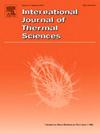Performance evaluation of a double-pipe heat exchanger using plain and rectangular-cut multi-channel twisted tapes
IF 4.9
2区 工程技术
Q1 ENGINEERING, MECHANICAL
International Journal of Thermal Sciences
Pub Date : 2025-05-29
DOI:10.1016/j.ijthermalsci.2025.109994
引用次数: 0
Abstract
This study numerically investigates the hydrothermal performance of multi-channel twisted tapes (MCTTs), including plain and rectangular-cut trilobe, quadlobe, and pentalobe designs, inside a double pipe heat exchanger (DPHE). The objective is to enhance turbulent heat transfer while maintaining a feasible pressure drop. The finite volume approach is used to solve the steady-state Navier–Stokes and energy equations, that serve as the basis of the mathematical model. The realizable and SST models were employed for turbulence modeling. Assumptions include incompressible and steady-state water flow while neglecting thermal radiation, gravity, and chemical reactions. The study evaluates the heat exchangers by comparing the Nusselt number (Nu), friction factor (f), and thermal performance factor (TPF) against conventional twisted tapes and plain DPHE. The simulations consider a twist ratio of 3.0, a 39 mm pitch, constant cut depth of 4.4 mm, cut widths of 4.8 mm and 4.4 mm, and an edge length between two cuts measuring 6.5 mm and 13 mm. The study employed water as the working fluid and was performed in the turbulent flow regions, characterized by a range of 6000 to 20000. Water is assumed to be an incompressible, steady-state fluid, with constant density and flow rate, while neglecting thermal radiation, and gravity. The hot water exhibits a counterflow pattern within the inner side, with a mass flow rate that can vary whereas the cold water flows through the annular side at a consistent mass flow rate. In order to choose the appropriate turbulence model, the simulation results for a plain DPHE and a heat HX with conventional twisted tape (TT) were compared with available empirical correlations. Afterwards, the multi-channel twisted tapes (MCTTs) were simulated using the more precise model. Results show that MCTTs induce multiple swirling flows, enhancing fluid mixing and heat transmission. Among the tested designs, rectangular-cut trilobe twisted tape (RC-MCTT) at wd 4.4 mm achieved the highest Nu, with a 105%–170% increase over P-DPHE and 62%–94% over DPHE with typical TT. Similarly, the plain trilobe MCTT provided a 73%–150% improvement over P-DPHE and 37%–80% over DPHE with typical TT. The maximum TPF of 1.31 was observed for RC-MCTT at . These findings confirm that rectangular-cut MCTTs significantly enhance heat transfer while maintaining a reasonable trade-off with pressure drop, making them a promising choice for industrial heat exchanger applications.

采用平切和矩形多通道扭带的双管换热器的性能评价
本研究对双管换热器(DPHE)内的多通道扭曲带(mctt)的热液性能进行了数值研究,包括普通和矩形切割三叶、四叶和五叶设计。目的是在保持可行的压降的同时增强湍流传热。有限体积法用于求解稳态Navier-Stokes方程和能量方程,这是数学模型的基础。采用可实现的k−ε和SST k−ω模型进行湍流建模。假设包括不可压缩和稳态水流,而忽略热辐射、重力和化学反应。该研究通过比较Nusselt数(Nu)、摩擦系数(f)和热性能系数(TPF)来评估热交换器与传统扭曲带和普通DPHE的区别。模拟考虑扭比为3.0,节距为39毫米,切割深度为4.4毫米,切割宽度为4.8毫米和4.4毫米,两个切口之间的边缘长度分别为6.5毫米和13毫米。本研究采用水作为工作流体,在湍流区进行,其特征范围为6000 ~ 20000。假设水是一种不可压缩的稳态流体,具有恒定的密度和流量,同时忽略热辐射和重力。热水在内侧表现出逆流模式,其质量流量可以变化,而冷水则以恒定的质量流量流过环形侧。为了选择合适的湍流模型,将普通DPHE和传统扭曲带(TT)热HX的模拟结果与现有的经验相关性进行了比较。然后,使用更精确的模型对多通道扭曲带(mctt)进行模拟。结果表明,mctt诱导了多次旋流,增强了流体的混合和传热。在试验设计中,w=d = 4.4 mm的矩形剪切三叶扭曲带(RC-MCTT)的Nu值最高,比P-DPHE高105% ~ 170%,比典型TT的DPHE高62% ~ 94%。同样,普通三叶MCTT比P-DPHE改善73%-150%,比典型TT的DPHE改善37%-80%。Re=6000时,RC-MCTT的TPF最大值为1.31。这些研究结果证实,矩形切割的mctt显着增强了传热,同时保持了合理的压降权衡,使其成为工业热交换器应用的有希望的选择。
本文章由计算机程序翻译,如有差异,请以英文原文为准。
求助全文
约1分钟内获得全文
求助全文
来源期刊

International Journal of Thermal Sciences
工程技术-工程:机械
CiteScore
8.10
自引率
11.10%
发文量
531
审稿时长
55 days
期刊介绍:
The International Journal of Thermal Sciences is a journal devoted to the publication of fundamental studies on the physics of transfer processes in general, with an emphasis on thermal aspects and also applied research on various processes, energy systems and the environment. Articles are published in English and French, and are subject to peer review.
The fundamental subjects considered within the scope of the journal are:
* Heat and relevant mass transfer at all scales (nano, micro and macro) and in all types of material (heterogeneous, composites, biological,...) and fluid flow
* Forced, natural or mixed convection in reactive or non-reactive media
* Single or multi–phase fluid flow with or without phase change
* Near–and far–field radiative heat transfer
* Combined modes of heat transfer in complex systems (for example, plasmas, biological, geological,...)
* Multiscale modelling
The applied research topics include:
* Heat exchangers, heat pipes, cooling processes
* Transport phenomena taking place in industrial processes (chemical, food and agricultural, metallurgical, space and aeronautical, automobile industries)
* Nano–and micro–technology for energy, space, biosystems and devices
* Heat transport analysis in advanced systems
* Impact of energy–related processes on environment, and emerging energy systems
The study of thermophysical properties of materials and fluids, thermal measurement techniques, inverse methods, and the developments of experimental methods are within the scope of the International Journal of Thermal Sciences which also covers the modelling, and numerical methods applied to thermal transfer.
 求助内容:
求助内容: 应助结果提醒方式:
应助结果提醒方式:


